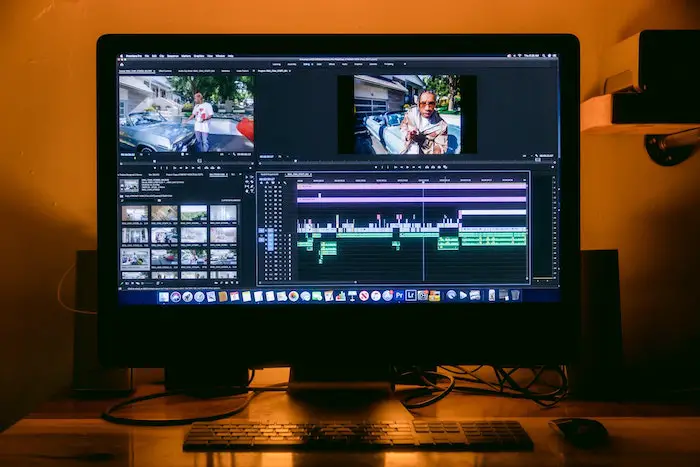
In filmmaking, the right tools and technologies play an important role in bringing creative visions to life. In this post, we delve into an essential aspect of the filmmaking process: choosing between internal and external drives for storing and editing your projects. This decision, though seemingly technical, has far-reaching implications on the efficiency, convenience, and overall quality of your work. We’ll explore various facets of this choice, from evaluating the performance of different drive types to understanding the nuances of file systems and their impact on your workflow. Whether you’re a seasoned filmmaker or just starting out, this valuable guide aims to provide you with insights and practical tips to optimize your storage solutions and enhance your filmmaking experience.

Speed and Reliability of Internal vs. External Drives
When it comes to storing and editing log footage or any other compressed video format, the choice between an internal or external drive is pivotal. Internal drives, seamlessly integrated with your computer’s operating system, generally offer faster data transfer rates.
This speed is crucial when working with large files typical in filmmaking, especially if you’re dealing with log format, which tends to produce very flat footage requiring intensive processing. However, an internal drive’s capacity can be limiting, and upgrading it often means navigating complex disk utility tools or even requiring a bootable Windows USB drive for installation.
External drives, on the other hand, provide flexibility and additional storage without the hassle of tinkering with your system’s internals. While they may not match the speed of internal drives, modern external solutions have significantly closed this gap, especially those compatible with the Apple File System (APFS) or the exFAT file system.
These systems are designed for high-volume and high-performance needs, offering efficient storage for large video files. Plus, the ease of using a disk management tool to drive and select formats for an external drive makes it a favorite for filmmakers who value convenience and portability alongside necessary performance.
Another aspect to consider is file security. While internal drives may benefit from the basic file security protocols of your computer’s default file system, external drives offer the advantage of being physically removable. This means you can store them separately from your main system, reducing the risk of data loss due to system failure or malware attacks.
In terms of file systems, the exFAT file system is often preferred for external drives due to its compatibility across different operating systems, making it ideal for filmmakers who use multiple devices or collaborate with teams that do. Whether you choose an internal or external drive for your filmmaking projects, understanding these factors ensures you make an informed decision that best suits your workflow and security needs.

When to Choose an External Drive for Your Film Projects
The decision between using an internal or external drive often comes down to the need for convenience and portability. External drives shine in scenarios where mobility is key. For instance, when shooting on location, an external drive allows you to quickly and easily back up footage directly from your camera or other recording devices. This convenience is invaluable in fast-paced shooting environments where time and space are limited.
Additionally, external drives offer the flexibility of being used across different devices, a significant advantage for filmmakers who might be working on various systems or collaboratively with teams who have different hardware.
However, convenience shouldn’t come at the cost of performance. While external drives may not always match the speed of their internal counterparts, advancements in technology have significantly narrowed this gap. Modern external drives equipped with USB 3.0 or Thunderbolt connections can offer speeds that are more than adequate for editing even high-resolution video files. The key is to choose a drive that aligns with your specific needs, whether it’s for storing footage or accessing files rapidly during intensive editing sessions.
Lastly, understanding how to format a hard drive is crucial when working with external drives. Here’s a quick tutorial: To format your hard drive, begin by ensuring all important data on the drive is backed up, as formatting will erase all content. Connect the drive to your computer and open the disk management tool, which you can find in the system settings for both Windows and Mac operating systems.
In the disk management interface, locate your drive, then right-click (Windows) or use the appropriate action (Mac) to select the option to format the drive. You’ll be prompted to choose a file system; common choices include NTFS for Windows or exFAT for compatibility with both Windows and Mac. Confirm your selection and start the formatting process. Remember, formatting a drive will erase all existing data, so be certain you’ve saved everything you need from the drive before proceeding.
Ensuring proper format can optimize your drive’s performance and reliability. For filmmakers, this means less time dealing with technical issues and more time spent focusing on the creative aspects of their projects. By weighing these factors, filmmakers can make an informed decision on when and how to incorporate external drives into their workflow, striking the perfect balance between convenience, compatibility, and performance.

Maximizing Storage Capacity and File System Compatibility in Filmmaking
Maximizing storage capacity is a crucial aspect of the workflow. It’s also an important aspect to consider the compatibility of file systems between different drives and devices. Filmmakers often work in diverse environments, using various cameras and editing on different operating systems. This diversity demands a file system that is universally compatible and efficient.
For instance, a drive formatted for Windows might not work seamlessly with a Mac without the right file system. Understanding these compatibility nuances ensures a smooth, hassle-free experience when transferring and accessing files across different devices. This is especially relevant when working in collaborative settings where files need to be shared among various team members and collaborators.
Finally, the choice between an internal or external drive can also influence the overall efficiency of your editing process. External drives obviously offer the advantage of portability, making it easier to transport and share large files. They are also less susceptible to system crashes, providing an additional layer of security for your valuable footage.
However, the convenience of external drives should be weighed against their relative speed and the potential need for additional backups. In contrast, internal drives, while limited in portability, offer faster data access, which can be a significant advantage when working with complex video editing software and large files.
Balancing these factors – storage capacity, file system compatibility, and the specific demands of your filmmaking projects – will help you choose the most suitable storage solution, ensuring a smooth and efficient video editing process.
Final Thoughts
The choice between internal and external drives in filmmaking is more than just a technical decision – it’s a strategic one that can significantly impact the quality and efficiency of your workflow. By considering the specific requirements of your projects, you can make informed decisions that best suit your needs. Remember, each type of drive has its own set of advantages and limitations, and the key is to find a balance that complements your workflow and supports your creative ambitions.





